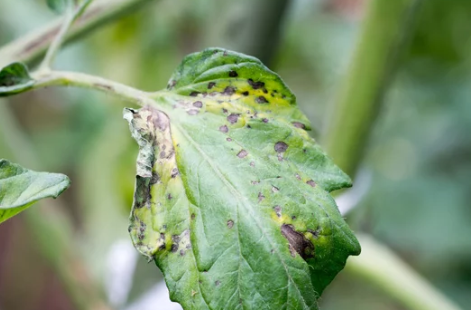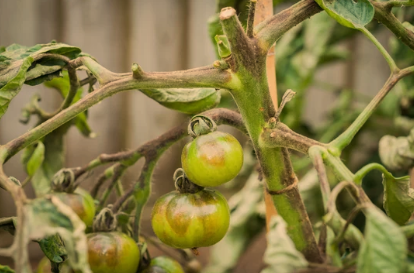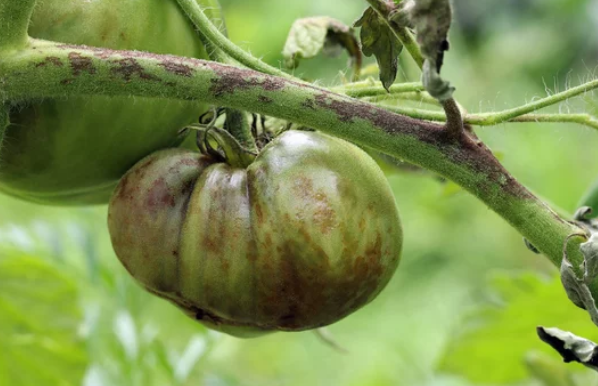Those who are committed to growing tomatoes, including amateur and expert gardeners, find black spots on their prized plants to be not only discouraging but also possibly disastrous.
Finding the distinctive characteristics of black spots is an important first step because they frequently resemble other diseases with comparable appearances.
Black spots on tomatoes can be caused by a variety of circumstances.
They include bacterial and fungal infections as well as different environmental factors that cause these troublesome signs.
Understanding the variety of ways to treat and prevent this frequent horticultural ailment is equally important.

Eradicating Black Spots on Tomatoes
Identification and Causes of Black Spots
Identification of Black Spots on Tomatoes
Black spots on tomatoes are a common symptom of various diseases and environmental stressors.
They can range from tiny, dark specks to larger patches. Predominantly, these spots are found on the fruit itself but can appear on the stalks and leaves too.
It’s crucial to identify and remove affected tomatoes immediately to prevent a further spread of disease.
To identify black spots, carefully examine your tomato plants on a regular occasion, paying special attention to the fruit.
The initial signs of the disease can be tiny spots that are black or dark brown.
They may appear sunken and can gradually increase in size. Sometimes, a yellow or tan halo may surround these spots. As the disease progresses, the infected parts dry up and become tough or leathery.
Differentiating black spots from other tomato diseases might prove somewhat challenging.
In comparison, blossom-end rot is characterized by the appearance of a water-soaked spot at the blossom end of the tomato.
Additionally, the color of this spot may be chocolate brown or black. Bacterial spot and speck manifest in raised or corky pitch-black spots.
Causes of Black Spots in Tomatoes
Several factors could lead to the development of black spots in tomatoes. The leading causes include bacterial and fungal infections, as well as certain environmental factors.
Two types of bacterial infections can cause black spots: bacterial speck and bacterial spot. The former caused by Pseudomonas syringae pv. tomato and the latter due to Xanthomonas campestris pv. vesicaria.
Fungal infections can be another common cause of black spots in tomatoes. Septoria leaf spot and early blight are two primary fungal diseases which can produce black spots on tomatoes.
Environmental factors like insufficient calcium in the soil can also cause black spots on tomatoes. Additionally, extreme fluctuations in temperature and moisture, inadequate watering, and poor gardening practices can contribute to the development of these spots.
Understanding the type and cause of black spots on tomatoes is fundamental for effective treatment and control. Regular inspection of plants, maintaining proper watering and fertilization, and prompt removal of infected parts are some of the practices that can help control the spread and impact of black spots on tomatoes.

Treatment and Prevention Methods
Recognizing the Problem: Black Spots in Tomatoes
The issue of black spots appearing on tomatoes is a challenge that many gardeners face across the country.
This symptom is often caused by a fungal infection. Fungal disease in tomatoes is no small matter, it not only affects the quality and yield of your tomatoes but can also lead to plant death if not treated timely and accurately.
Treatment: Your First Line of Action Against Black Spots in Tomatoes
Upon noticing the black spots, the first line of action would be to remove the affected tomatoes or leaves.
Dispose of these off in a way that won’t intensify the issue or spread the fungus to other areas of your garden.
There are several treatments available for these black spots. One such treatment is the use of fungicides.
Apply a product that contains chlorothalonil or mancozeb every seven to 10 days. Read and follow the package instructions carefully for the best results.
Alternatively, copper-based fungicides could also be used as they attack the fungi that cause black spots.
The introduction of a bio-remedy could also be a natural and environment-friendly option.
Bio-remedies include introducing beneficial microbes that can compete with the disease-spreading fungi or bacteria.
Seek out products containing the bacterium Bacillus subtilis or the fungus Trichoderma harzianum, among others.
These microbes colonize the plant roots and prevent disease-causing organisms from establishing themselves.
Prevention: Stopping the Spread of Black Spots in Tomatoes
The next step after effectively treating your plants is to put preventive measures in place to avoid recurrence. The main idea behind these measures is to create an environment that is unfavorable for fungi. One such measure includes crop rotation – not planting tomatoes in the same soil where any member of the Solanaceae family (like peppers, eggplants, or potatoes) have been planted in the last three years.
Plant spacing and pruning is another significant prevention method. Proper spacing and pruning ensure good air circulation, which dries out the foliage quickly and makes it less hospitable to diseases.
Tomatoes should be planted at intervals of at least 36 inches and rows should be spaced about 48 inches apart.
All drying, yellowing, or diseased limbs should be pruned regularly to maintain plant health.
Lastly, ensure that irrigation is performed in a way that the leaves do not get wet. Damp leaves provide the perfect environment for the growth of fungi.
Keeping your garden clean from plant debris, providing proper nutrition through rich compost, and maintaining a balanced pH in the soil are also effective prevention strategies.
With these measures in place, a gardener can effectively manage black spots in tomatoes and maintain the health and productivity of their plants.

Eradicating Black Spots on Tomatoes
A plentiful and healthy tomato harvest depends on ongoing vigilance against potential diseases like the emergence of black spots.
Black spots can be stopped from spreading or recurring with the help of accurate diagnosis techniques, appropriate treatment techniques like the use of fungicides or bio-remedies, as well as the adoption of preventative strategies like proper spacing, pruning, or even crop rotation.
Hence, adopting these tactics can greatly help anyone involved in tomato production, whether they are professionals or amateurs.
This will ensure a successful tomato output full of delectable, flawless fruits.




